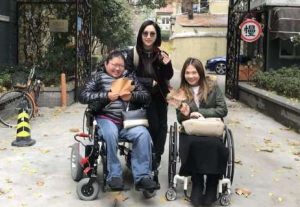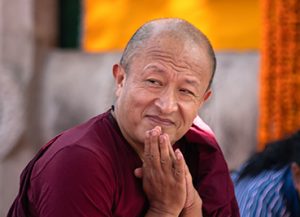
Young people today face immense pressure to find themselves at an early age and stay true to that identity throughout their lives. Although this pressure is not new, the age of social media has introduced an added burden for individuals to consistently reaffirm their identities in the public eye. While finding oneself may sound like an enlightening experience, it is no more than creating and then trying to protect the illusion of a false identity, which brings about suffering. To alleviate this suffering constructed from artificiality, we must work to understand our egos and let go of our ideas of who we are. Letting go of the “self” is an incredible challenge, but the Buddha’s teachings on non-self (Skt: anatman) can help us begin to address it.
In a Western context, people often equate “having an ego” with being self-centered, while the Buddha referred to the ego as the perceived sense of self that one develops throughout life. Essentially, this “self” is a construct of the mind that creates a sense of separateness and attachment to one’s identity. While one can certainly draw connections between egotistical hubris and the ego as the self, the Buddha’s teaching more clearly demonstrate how our egos can harm ourselves and others.
What is the self?
To further explore the Buddhist teachings on the “self,” we must first look at the Buddha’s foundational teaching of impermanence (Skt: anitya). Essentially, everything in the world is evolving continuously. Even when it is slow and gradual, change is the one constant we should expect from existence. While impermanence is certain, the process is not, and many tend to resist it because impermanence always entails some sort of loss.
The primary way that people resist change is through forming attachments to things. We tend to become dependent on certain perceptions or ideas of the world—how it is and how we believe it should be. We crave consistency and find comfort in people, things, and situations remaining stagnant. But, if all that exists is impermanent, nothing should be grasped or held onto. When we hold on or attach to something, we set ourselves up for disappointment when that thing, person, or situation inevitably changes. The practice of non-attachment is a state in which a person overcomes those attachments to desire for certain concepts or things, which often leads practitioners to act with a heightened sense of patience, compassion, and wisdom.

So what does this mean for our “selves?” The Buddha taught that one of the most damaging attachments one can have is ego attachment, or an attachment to the sense of self. This type of attachment directly ties to the illusion of a permanent, separate self. When we adopt beliefs about ourselves, we begin to feel that certain qualities define us and give us value. Because we tend to define ourselves through our egos, we often feel that losing one or more of these qualities would equate to losing ourselves. Whatever characteristics or interests we think we need to have in order to “be ourselves”—whether a job title, a lifestyle, a label, or a belief system—are all attachments. We cling to these things and are devastated when we lose them. Consider the qualities you might list when someone says, “Tell me about yourself.” Many of these have likely become ego attachments.
The struggle of social media
For young people in the modern world, the increased social pressure to have a defined sense of self is more overwhelming than ever before. In recent years, social media has become an omnipresent force in the lives of young people, shaping their perceptions of others and their expectations of themselves. From an early age, developing young minds are exposed to media that pressure them to believe they must create a carefully curated online persona and embody that idealized version of themselves in the real world. This pressure arises from the desire for validation and acceptance from peers and the broader online community. As a result, young people often feel compelled to present only the most flattering aspects of their lives while concealing everything else.
Additionally, the careful curation of an “ideal self” often encourages people to overuse labels. While labels can provide a valuable sense of identity and belonging, they can also be restrictive and confining, pigeonholing individuals into narrow categories that may not fully represent their complexity. Social media heavily reinforces the notion that we must be unchanging entities to achieve fulfillment, but in reality this is unattainable. The desire for acceptance that comes with heightened social pressures often leads people to limit themselves to labels and descriptors that they feel give them purpose. Whether they feel right because those labels truly make one happy in the moment, or because they warrant the approval of others, the problem is that all people are guaranteed to change over time. As a result, many of these labels will cease to reflect the individual who has grown attached to them, which has the potential to lead to identity- and comparison-based self-loathing.
When I began my first year of college in the fall of 2019, I fully believed that I would find my “true self.” With that, I expected, would come a set of hobbies, interests, and people—a group where everyone was their true self yet somehow just like me. Everything would fit just right and it would stay that way. I desperately wanted to be an ideal, stagnant entity that I saw others my age emulating online. So I naturally began feeling lost when I inevitably failed to morph into the perfect version of myself that I had spent so much time curating. I had prescribed myself a set of labels, knew who I wanted to be, and decided what “kind” of people I wanted to be accepted by. Because I developed an attachment to these things, my transition to college was significantly more challenging due to the disappointment I felt in myself.

Although I did not recognize it at the time, my experience was not an uncommon one. The relentless pursuit of perfection and the rigid adherence to labels have detrimental effects on the well-being of young people everywhere. In the digital age, it is easy to fall into patterns of constantly comparing oneself to the seemingly flawless online personas of others, which leads to feelings of inadequacy. Moreover, the pressure to conform to specific labels or ideals often results in a loss of authenticity and self-expression, as individuals prioritize fitting into predetermined molds over allowing themselves to navigate the world with an open mind. When someone deems themself as a specific type of person, that persona becomes linked to their ego, ultimately closing them off to a wide variety of potential opportunities and experiences that do not “fit” their image, which is made up of ego attachments.
Even when someone is successful in momentarily shaping themself into their desired mold, they will still change. When this happens, they might become overly self-critical. For example, imagine someone who has spent much of their life playing a particular sport. That person likely considers themself an “athlete.” Imagine that this person injures themself and can no longer play their sport. Because of their attachment to the label “athlete,” adjusting to the changes in their life will be exponentially more complicated. Not only will they experience a lifestyle change (which can be frustrating on its own), but they will likely struggle with the belief that they have lost a part of themself and feel incomplete.
In my own experiences, I have often become attached to labels based on my passions and interests. Some general examples would be “artist” or “musician.” As I have grown and changed, I have naturally lost interest in some of the things I once loved. Instead of accepting the impermanent nature of the self, I have spent significant time resisting my development and beating myself up over it. Not only have these changes made me feel incomplete, they have also resulted in immense insecurities about how others perceive and label me. Even more disheartening is that I have closed myself off to many potential hobbies, interests, and opportunities throughout much of my youth because I possessed a very surface-level view of what was “me.”
Only when I was introduced to the Buddha’s fundamental teaching of non-self did I begin to let go of the labels and ego attachments that I truly believed gave me my worth. Based upon the law of impermanence, the Buddha rejected the notion of a permanent, unchanging self that persists independently throughout one’s life. Non-self simply challenges the idea of a fixed, inherent self. Instead, it proposes that we perceive ourselves as a dynamic interplay of various factors such as body, mind, sensations, perceptions, and consciousness. These components are all impermanent and subject to constant change.
Recognizing the impermanent nature of the self can help young people dismantle the illusion of the idealized persona they feel pressured to portray on social media and in real life. Understanding that online identities are simply constructs, influenced by external factors, can alleviate the burden of living up to unrealistic standards. Additionally, the practice of non-self encourages individuals to let go of rigid identities and labels, recognizing that these are merely temporary designations. By cultivating a fluid sense of self, young people can liberate themselves from the constraints of prescribed categories and embrace a multifaceted nature of being. This insight has immense potential to encourage young people to cultivate authenticity and self-acceptance.

In my third year of college, after almost two full years of trying (and failing) to become a picture-perfect and unchanging version of myself, I was introduced to non-self through a self-help book on mindfulness. The chapter on non-self was just a few pages, but I found myself reading it repeatedly, highlighting the phrases that stuck out to me, and making notes in the margins about all of my ego attachments. As I realized how much of my own suffering I had been creating, it felt as though a weight was being lifted off of my shoulders. Not long after, I led a conversation about non-self in a college group. That was when I realized I was not alone in the self-versus-ego battle. In a group of young adults, some of us strangers, we bonded over similar feelings of uncertainty and distress caused by destructive social pressures to appear perfect and unchanging. That evening, someone told me, “You do not owe anybody consistency. You owe yourself endless possibilities,” which I immediately scribbled down on a scrap of paper that I still carry with me two years later.
Now, I am only 23 years old and nowhere near ridding myself of my ego-driven thought patterns, but understanding non-self has helped me tremendously to navigate the world. Given the social pressures of being a young person in the 21st century, practicing non-self requires immense concentration and effort. I still find myself clinging to labels and descriptions, and the weight of ego attachment still weighs on me, some days heavier than others. We are conditioned to think that there are things that we are, and we should feel uncomfortable when we begin to act in ways that do not reflect our “true” selves. One of the fundamental practices of non-self that young people may find helpful is to stop using labels—or at least to rely on them less often. It is important to remember that rejecting unnecessary labels does not mean abandoning interests, qualities, passions, beliefs, and values. Rather, the practice is in understanding and being open to the fact that while those are all important, they will likely change over time. We should ultimately be empowered by the understanding that nothing can ever make us any less or more “ourselves.” We just are.
The Buddhist practice of non-self offers young people a profound framework for navigating the complexities of social media and transcending ego-driven pressures, both online and offline. It takes constant awareness and hard work to alleviate those pressures, but when we deeply investigate the nature of self through mindfulness and introspection, we find that there is no singular, unchanging entity we can point to as “me” or “mine.” Instead, our sense of self arises from the continuous interaction of various transient elements. By embracing impermanence, letting go of fixed identities, and cultivating authenticity and compassion, young people can foster a healthier relationship with themselves, their peers, and the digital world. We do not have to “know” ourselves in the stereotypical way to know that we can love and accept ourselves as we are in each and every moment.
Related features from BDG
Self, No-Self, or Self
Buddhistdoor View: Here Be Dragons – A Year of Transformation and Thunderstorms
Uncertainty, Insecurity, and Instability
BDG Special Issue
Digital Dharma – Buddhism in a Changing World












